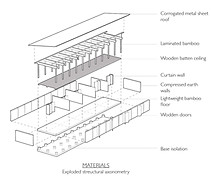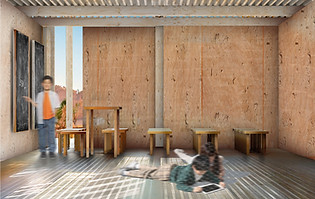









Nepal school
Competition proposal (finalist)
spring 2025 (2 weeks)
A Prototype for Eco-Friendly, Earthquake- and Flood-Resistant Rural Schools in Nepal. In the aftermath of repeated natural disasters in Nepal, particularly earthquakes and monsoon floods, there is a pressing need for safe, durable, and community-centered educational infrastructure. This project proposes a replicable modular prototype designed to empower rural communities through self-built, disaster-resilient, and environmentally conscious architecture.
This initiative aims to foster a sense of ownership, identity, and interconnection, making schools not only centers of learning but also beacons of resilience and unity during times of crisis.
The building system merges earthquake- and flood-resilient techniques with local craftsmanship and materials, ensuring both safety and cultural relevance. The structure sits on a raised plinth, enhanced with base isolation using sand-filled recycled truck tires—a cost-effective method that reduces seismic shock and also allows water to drain freely beneath the building during monsoon rains, guided by gravel beds and drainage trenches.
Above this resilient base, a light bamboo frame supports the building program, ideal for quick assembly and climate protection. The walls are made from rammed earth or Compressed Stabilized Earth Blocks (CSEB) using soil sourced on-site, blending thermal performance with environmental harmony. Bamboo doors, ceilings, and operable shutters regulate ventilation, sunlight, and privacy, allowing each classroom to adapt naturally to Nepal’s seasonal climate while maintaining a secure and comfortable indoor environment.
A 1,5m x 1,5m modular grid serves as the foundational framework for the school’s design, ensuring consistency in construction, ease of local fabrication, and the potential for widespread replication across diverse rural terrains in Nepal. This system supports scalable, phased development, allowing communities to construct the school incrementally based on available resources and needs.
Each program is housed in independent yet interconnected volumes, providing flexibility and structural safety while reinforcing the courtyard-centered spatial arrangement. This modular layout supports both functional diversity and community resilience, making the school a true engine for regeneration in disaster-affected rural areas.
The project aims to minimize environmental impact and reduce long-term energy needs by integrating passive design strategies and local ecological practices. A double-roof system is employed, with a lightweight metal sheet roof raised above the primary structure to create shaded galleries that shield walls from heavy monsoon rains and intense sun—enhancing both comfort and material longevity.
The ventilated cavity between the two roofs allows hot air to rise and escape, generating a natural stack effect that supports continuous cross-ventilation. The design incorporates rainwater harvesting systems, solar panels for backup power, and a commitment to preserve existing vegetation while planting new species for shade, food, and biodiversity. These elements come together to create a low-impact, climate-adaptive learning environment that promotes resilience and sustainability at every level.

